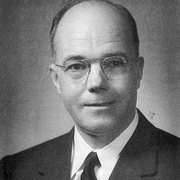Henry G. Houghton (1905–1987)
Henry Garrett Houghton received his BS in 1926 from the Drexel Institute of Technology; his SM in electrical engineering in 1927 from the Massachusetts Institute of Technology and was a member of the research staff at MIT's Round Hill Research Station from 1928 to 1938. He became assistant professor of meteorology at MIT in 1939, associate professor and executive officer of the Department of Meteorology in 1942, and professor and head of the department in 1945, serving until his retirement in 1970.
At Round Hill, his meteorological work dealt with the fundamental physical properties of fog, equipment and methods for measuring fog particles, and the transmission of light and infrared radiation through fog and clouds. These studies led to the development in 1934 of one of the first practically tested ways of artificially dissipating fog over local areas by the use of calcium chloride spray.
During World War II he trained weather personnel for the Army and Navy and was a member of several committees working on infrared and heat radiation as well as meteorological and de-icing problems. His research focused on the nature of atmospheric condensation processes and the transmission of light and infrared radiation through fog and clouds, resulting in a new research field now known as cloud physics.
In addition, he was a member of the University Meteorological Committee, which coordinated military training programs in meteorology and advised the armed services on technical problems in meteorology. He also served as chairman of the panel on meteorology of the Joint Research and Development Board and chairman of the panel for weather and upper air research of the Scientific Advisory Board to the Commanding General of the Air Forces.
Houghton was instrumental in the formation of the University Corporation for Atmospheric Research in 1959 and served as first chairman of its board. In 1958, Houghton received the Charles F. Brooks Award from the AMS and was an honorary member of the Society, serving as its president (1946-1948) and as secretary (1956-57).
